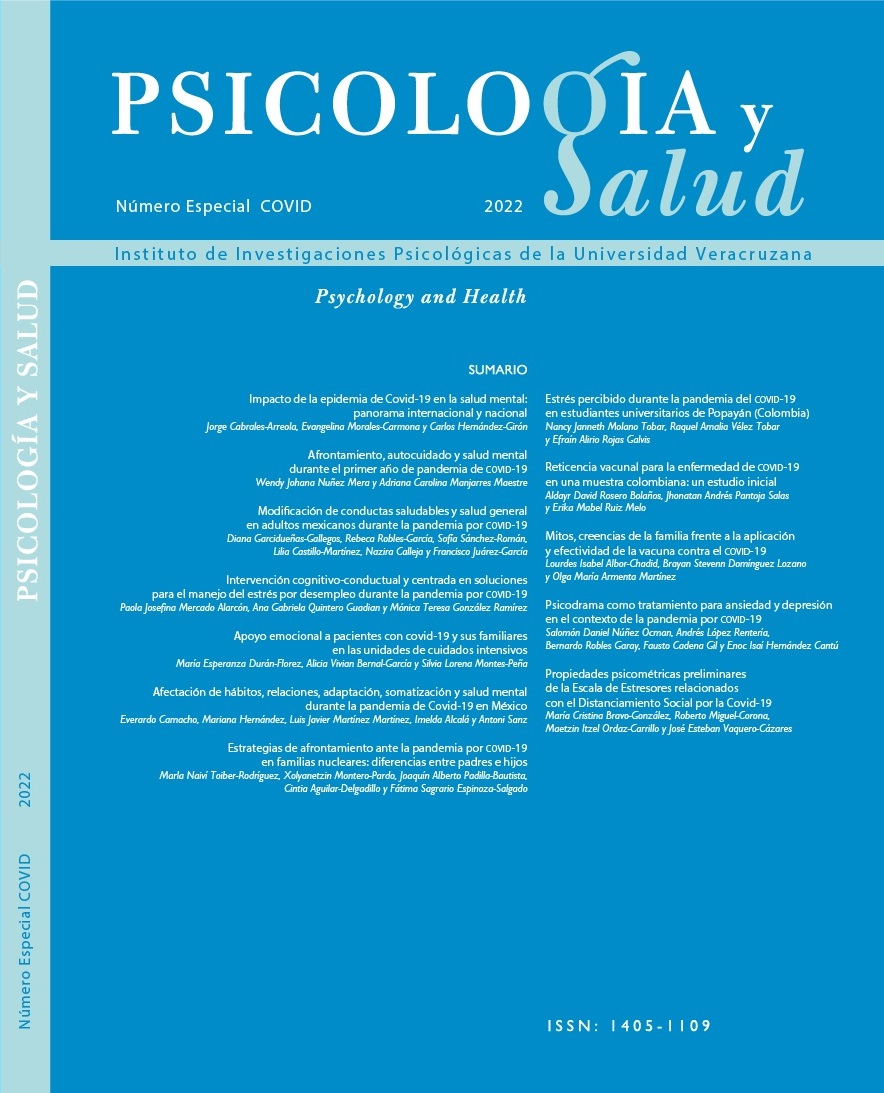Abstract
As a result of the health contingency derived from a large number of COVID-19 infections, various worldwide strategies aimed at reducing the spread of the virus. In Mexico, the instruction "Healthy Interpersonal Distance" involved efforts to social distancing for the population. Thus, evaluating the perception of stress generated by such situations became necessary. The development of the Scale of Stressors related to Social Distancing by COVID-19 contributed to this end. Objective. To describe this process and analyze the scale's psychometric properties with a sample of 2,656 residents in Mexico. After the exploratory factor analysis and Cronbach's alpha coefficient, the final version consists of 16 items grouped into four factors after eliminating ten items. The results show satisfactory indexes for the total of the scale and each factor. The present findings suggest that the scale is valid and reliable for evaluating the stressors related to situations of social distancing. However, the confirmatory factor analysis still requires implementation.
References
Aerny P.N., Domíguez B., M.F., Astray, M.J., Esteban V., M.D., Blanco A., L.M. y López P., M.A. (2012). Tasas de respuesta a tres estudios de opinión realizados mediante cuestionarios en línea en el ámbito sanitario. Gaceta Sanitaria, 26(5), 477-479. Doi: 10.1016/j.gaceta.2011.10.016.
Brooks, S.K., Webster, R.K., Smith, L.E., Woodland, L., Wessely, S., Greenberg, N. y Rubin, G.J. (2020). The psychological impact of quarantine and how to reduce it: rapid review of the evidence. The Lancet, 395, 912-920. Doi: 10.1016/ S0140-6736(20)30460-8.
IBM Corporation (2019). IBM SPSS Statistics for Mac, V. 26.0 [software de cómputo]. Armonk, NY: IBM Corp.
Jaspal, R., Lopes, B. y Lopes, P. (2020). Predicting social distancing and compulsive buying behaviours in response to COVID-19 in a United Kingdom sample. Cogent Psychology, 7, 1-14. Doi: 10.1080/23311908.2020.1800924.
Kerlinger, F.N. y Lee, H.B. (2002). Investigación del comportamiento. Métodos de investigación en ciencias sociales. México: McGraw-Hill.
Lazarus, R. y Folkman, S. (1986). Estrés y procesos cognitivos. Barcelona: Martínez Roca.
Lesmana, N. (2018). The relationship between stress level and coping mechanism against the regulation dormitory quarantine. The Malaysian Journal of Nursing, 10(2), 131-136.
Lorca M., S., Carrera F., X. y Casanovas C., M. (2016). Análisis de herramientas gratuitas para el diseño de cuestionarios on-line. Revista de Medios y Educación, 49, 91-104. Doi: 10.12795/pixelbit.2016.i49.06.
Méndez, I., Namihira, D., Moreno, L. y Sosa, C. (1990). El protocolo de investigación. Lineamientos para su elaboración y análisis (2a ed.). México: Trillas.
Oblitas, A. y Sempertegui, N. (2020). Ansiedad en tiempos de aislamiento social por COVID-19. Chota, Perú, 2020. Avances en Enfermería, 38(1, suplemento), 11-21. Doi: 10.15446/av.enferm.v38n1supl.87589.
Reynolds, D., Garay, J.R., Deamond, S.L., Moran, M.K., Gold, W. y Styra, R. (2008). Understanding, compliance and psychological impact of the SARS quarantine experience. Epidemiology and Infection, 136, 997-1007. Doi: 10.1017/S0950268807009156.
Robertson, E., Hernshenfield, K., Lynn, S. y Stewart, D. (2004). The psychosocial effects of being quarantined following exposure to SARS: a qualitative study of Toronto health care workers. Canadian Journal of Psychiatry, 49(6), 403-407. Doi: 10.1177/070674370404900612.
Sandín, B., Valiente, R., García E., J. y Chorot, P. (2020). Impacto psicológico de la pandemia de COVID-19: Efectos negativos y positivos en población española asociados al periodo de confinamiento nacional. Revista de Psicopatología y Psicología Clínica, 25(1), 1-22. Doi: 10.5944/rppc.27569.
Smyth, J.D. y Pearson, J.E. (2011). Internet survey methods: a review of strengths, weaknesses, and innovations. En M. Das, P. Ester y L. Kaczmirek (Eds.): Social and behavioral research and the Internet. Advances in applied methods and research strategies (pp. 11-43). New York: European Association of Methodology & Taylor and Francis Group.
Vega, V., C.Z., Hernández T., R.A., García A., O., Nava Q., C. y Ruiz M., D. (2019). Escala de habilidades de solución de problemas en directivos: Desarrollo y validación. Evaluar, 19(3), 68-85. Doi: 10.35670/1667-4545.v19.n3.
Wang, C., Pan, R., Wan, X., Tan, Y., Xu, L., Ho, C.S. y Ho, R.C. (2020). Immediate psychological responses and associated factors during the initial stage of the 2019 coronavirus disease (COVID-19) epidemic among the general population in China. International Journal of Environmental Research and Public Health, 17, 1-25. Doi: 10.3390/ijerph17051729.
Xiang, Y.T. (2020) Timely mental health care for the 2019 novel coronavirus outbreak is urgently needed. The Lancet Psychiatry, 7, 228-229. Doi: 10.1016/S2215-0366(20)30046-8.

